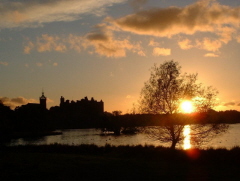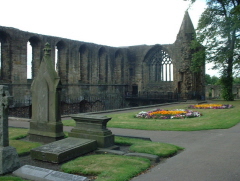The Aftermath - The Death and Retribution
 We have no account of the exact number of casualties but Pitscottie poetically alludes to a great slaughter:
We have no account of the exact number of casualties but Pitscottie poetically alludes to a great slaughter:
‘this matter beand finischit and money slaine and taine on baitht the sydis and in spetiall the earle of lennox witht money gentillmen of the wast land witht him and in lyke wyse the Earle of Glencairne ewil wondit to the deid and money of his freindis and serwandis slaine and also sum gentillmen of Fyfe baitht taine and slaine to wit, the Laird of Lethine slaine witht money wther gentillmen taine'
Mackay in translating Pitscottie suggests the Laird of Letham is David Sibbald in Fife
Johne Leslie adds another laird to the casualty list:
‘heir specialis ar slane the Erle of Lennox self, and the Laird of Houstoun, with mony ane of Lenox his parte.
This is Patrick Houston of Houston House. His lands were consequently ceded to the Hamiltons.
On the 13th September Magnus writes to Wolseley telling him of the battle and expressing opinions as to how best deal with the new order in Scotland. He mentions that the Abbots of Melrose and Dunfermline were:
‘breder and nephew to the sed Archbishop are slain and also his friend the Lord of Keir , John Stirling, Captain of Stirling and many others of his Kin.’
The Abbacy of Melrose was received from Robert Beaton by Andrew Dury in 1525, However it is most likely Robert who is killed at Linlithgow and Magnus is yet to catch up with change of job. The Abbot of Dunfermline at the time was Archbishop James Beaton having taken over from Andrew Foreman in 1522, supposedly on his death which suggests this claim is incorrect. However other sources state that it was Foreman who died at Linlithgow. Ferguson also adds Stirling of Kerr among the slain. However this could be incorrect as although he was with Lennox at the battle and had his lands taken from him as a result, he lived another 13 years before he was murdered at Stirling Bridge in revenge for his assassination of Buchanan of Leny. There may have been confusion as to who the casualty was or it was misreported.
Magnus also adds that:
‘Jas and Will[iam] Steward brothers of Lord Avondale are both slain. They were special servants to the Queen and brothers to Harry Stewarde who attends her grace’
This to is difficult to verify as the only legitimate brothers of Henry were Andrew 1st Lord of Ochiltree who died 1548 and James of Beith who died 1544.
Hopefully more research will identify who exactly fell at Linlithgow. What we do know is that no man of note was lost from the Hamiltons or Douglases.
So just how many men were killed that day? It is almost impossible to come up with a exact figure, none of the chroniclers suggest a number. All we can go on is the casualty figures from other battles of the period. If we look at Flodden and Pinkie we find somewhere in the region of 20 - 25% of the losing force were killed. If we agree that Lennox brought with him between 9,000 - 12,000 men then this would suggest a figure of around 2,500 killed on the Lennox side alone. Douglas and Hamiltons would of course have lost a much smaller number.
 The survivors fled the scene as best they could but the Douglases were soon rounding them up. Angus road for Stirling then to Dunferlime where he sacked the abbey in an attempt to get hold of Queen Margaret and Beaton however both had gone into hiding. It was said that the cardinal had disguised himself as a shepherd and was tending flocks on the Boroughmuir!
The survivors fled the scene as best they could but the Douglases were soon rounding them up. Angus road for Stirling then to Dunferlime where he sacked the abbey in an attempt to get hold of Queen Margaret and Beaton however both had gone into hiding. It was said that the cardinal had disguised himself as a shepherd and was tending flocks on the Boroughmuir!
The lords who fought for Lennox were summoned to appear before Angus over the ensuing months. A letter from Sir Christopher Dacre to Lord Dacre written on the 2nd Dec 1526 sums up their plight:
‘Lords Cassilis and Avondale are in the hands of Arran, and Sir James Hamilton, to ransom at their pleasure, with others of the West of the Party of Lennox, Lindsay and others of the same party are in the hands of Angus and Sir George Douglas, to whom the lands of Carr are forfeited’.
Some had been more fortunate than others:
‘Rynyame Creghton, who was in the keeping of Drumlarig, has agreed with him and been restored. Buckleugh is respited and was in Lithqw on Sunday to the great displeasure of the Carrs.’
Many lairds forfeited their lands and rents to appease Angus. Each swore allegiance to the King and his keepers.
Angus had successfully fought in the King’s defence three times and had won on each occasion. His enemies were not keen to face him a fourth time on their own. To make matters worse for James, the Earl of Cassilis, under threat of torture, handed over condemning letters detailing the king’s involvement in the uprising. The king would not be allowed to coordinate such a rebellion again. Angus set about surrounding James with all the luxuries of life; women, gambling, hawking and hunting was the order of the day. He hoped James would forget about his more kingly aspirations once he found succour in a maidens bedchamber. However the death of so many on his behalf had set James's mind. If he was to escape his captors then it was to be of his own making. Where an army had failled, he as a young king, would have to succeed.
It was not until 1528 that the king finally fled his captors. It took some careful negotiation with his stepfather to ensure Stirling Castle was given over to a sympathetic custodian and it was to here that he escaped on the 28th May. There he met with his mother and her loyal lairds. They in turn marched on Edinburgh one more time. This time however they had the king at their head! The minority was finally over.
Douglas was bottled up at Tantallon but survived a half hearted siege, before slipping away to exile in his brother in laws court. His time would come round again.
Perhaps the greatest legacy of this battle is the effect it all had on James's personality. He grew up into a ruthless and stubborn monarch, short tempered, trusting nobody but himself. His death at Falkland just days after the loss of his army at Solway Moss in 1542, was caused, some say, by the deep regret of losing so many men in his name. It could be said his reign came in with a battle and went out with a battle. Such is the legacy of the battle at the brig.

